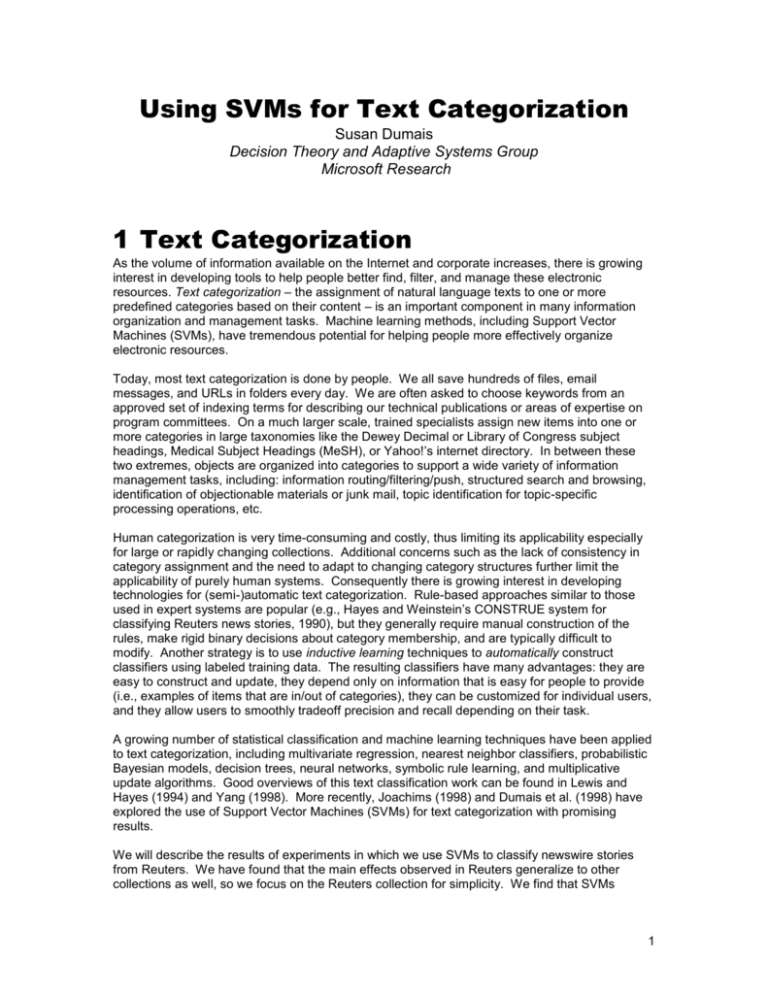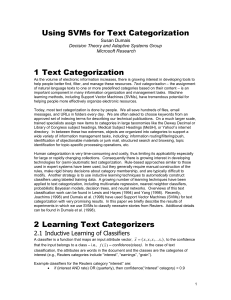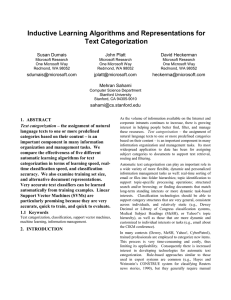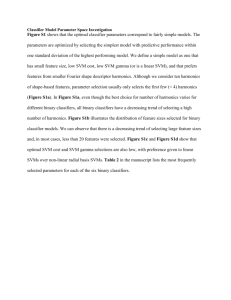1 Text Categorization
advertisement

Using SVMs for Text Categorization Susan Dumais Decision Theory and Adaptive Systems Group Microsoft Research 1 Text Categorization As the volume of information available on the Internet and corporate increases, there is growing interest in developing tools to help people better find, filter, and manage these electronic resources. Text categorization – the assignment of natural language texts to one or more predefined categories based on their content – is an important component in many information organization and management tasks. Machine learning methods, including Support Vector Machines (SVMs), have tremendous potential for helping people more effectively organize electronic resources. Today, most text categorization is done by people. We all save hundreds of files, email messages, and URLs in folders every day. We are often asked to choose keywords from an approved set of indexing terms for describing our technical publications or areas of expertise on program committees. On a much larger scale, trained specialists assign new items into one or more categories in large taxonomies like the Dewey Decimal or Library of Congress subject headings, Medical Subject Headings (MeSH), or Yahoo!’s internet directory. In between these two extremes, objects are organized into categories to support a wide variety of information management tasks, including: information routing/filtering/push, structured search and browsing, identification of objectionable materials or junk mail, topic identification for topic-specific processing operations, etc. Human categorization is very time-consuming and costly, thus limiting its applicability especially for large or rapidly changing collections. Additional concerns such as the lack of consistency in category assignment and the need to adapt to changing category structures further limit the applicability of purely human systems. Consequently there is growing interest in developing technologies for (semi-)automatic text categorization. Rule-based approaches similar to those used in expert systems are popular (e.g., Hayes and Weinstein’s CONSTRUE system for classifying Reuters news stories, 1990), but they generally require manual construction of the rules, make rigid binary decisions about category membership, and are typically difficult to modify. Another strategy is to use inductive learning techniques to automatically construct classifiers using labeled training data. The resulting classifiers have many advantages: they are easy to construct and update, they depend only on information that is easy for people to provide (i.e., examples of items that are in/out of categories), they can be customized for individual users, and they allow users to smoothly tradeoff precision and recall depending on their task. A growing number of statistical classification and machine learning techniques have been applied to text categorization, including multivariate regression, nearest neighbor classifiers, probabilistic Bayesian models, decision trees, neural networks, symbolic rule learning, and multiplicative update algorithms. Good overviews of this text classification work can be found in Lewis and Hayes (1994) and Yang (1998). More recently, Joachims (1998) and Dumais et al. (1998) have explored the use of Support Vector Machines (SVMs) for text categorization with promising results. We will describe the results of experiments in which we use SVMs to classify newswire stories from Reuters. We have found that the main effects observed in Reuters generalize to other collections as well, so we focus on the Reuters collection for simplicity. We find that SVMs 1 consistently provide the most accurate classifiers, and using the Sequential Minimal Optimization (SMO) methods discussed by Platt (1998; this article) learning the SVM model is very fast. 2 Learning Text Categorizers 2.1 Inductive Learning of Classifiers A classifier is a function, f (x ) confidence(class), that maps an input attribute vector, x ( x1,x2,x3,...xn ) , to the confidence that the input belongs to a class. In the case of text classification, the attributes are words in the document and the classes correspond to text categories (e.g., “acquisitions”, “earnings”, “interest”, for Reuters). Examples of classifiers for the Reuters category “interest” include: if (interest AND rate) OR (quarterly), then confidence(“interest” category) = 0.9 confidence(“interest” category) = 0.3*interest + 0.4*rate + 0.7*quarterly The key idea behind SVMs and other inductive learning approaches is to use a training set of labeled instances (i.e., examples of items in each category) to learn the classification function. In a testing or evaluation phase, the effectiveness of the model is evaluating using previously unseen instances. Inductive classifiers are easy to construct and update, and require only subject knowledge (“I know it when I see it”) not programming or rule-writing skills. 2.2 Text Representation and Feature Selection Each document is represented as a vector of words, as is typically for information retrieval (Salton & McGill, 1983). For most text retrieval applications, the entries in the vector are weighted to reflect the frequency of terms in documents and the distribution of terms across the collection as a whole. A popular weighting scheme is: wij = tfij*idfi, where tfij is the frequency with word i occurs in document j, and idfi is the inverse document frequency. The tf*idf weight is sometimes used for text classification (Joachims, 1998), but we have used much simpler binary feature values (i.e., a word either occurs or does not occur in a document) with good success (Dumais, et al., 1998). For reasons of both efficiency and efficacy, feature selection is widely used when applying machine learning methods to text categorization. To reduce the number of features, we first remove features based on overall frequency counts, and then select a small number of features based on their fit to categories. We used the mutual information, MI(X i, C), between each feature, Xi, and the category, C, to select features. MI(Xi, C) is defined as: MI ( X i , C ) xi X i ,c C P( xi , c) log P( xi , c) P ( x i ) P (c ) We select the k features for which mutual information is largest for each category. These features are used as input to the SVM learning algorithms. (Yang and Pedersen (1998) review several other methods for feature selection.) 2.3 Learning Support Vector Machines (SVMs) We used simple linear SVMs because they provide good generalization accuracy and because they are faster to learn. Joachims (1998) has explored two classes of non-linear SVMs, polynomial classifiers and radial basis functions, and has observed only small benefits compared to linear models. We used Platt’s Sequential Minimal Optimization (SMO) method (1998; this feature) to learn the vector of feature weights, w . Once the weights are learned, new items are classified by computing w x where w is the vector of learned weights, and x is the binary vector representing the new document to classify. We also learned two paramaters of a sigmoid function to transform the output of the SVM to probabilities. 2 3 An Example - Reuters 3.1 Reuters-21578 The Reuters collection is a popular one for text categorization research and is publicly available at: http://www.research.att.com/~lewis/reuters21578.html. Other popular test collections include medical abstracts with MeSH headings (ftp://medir/ohsu.edu/pub/ohsumed), and the TREC routing collections (http://trec.nist.gov). We used the 12,902 Reuters stories that had been classified into 118 categories (e.g., corporate acquisitions, earnings, money market, grain, and interest). We followed the ModApte split in which 75% of the stories (9603 stories) are used to build classifiers and the remaining 25% (3299 stories) to test the accuracy of the resulting models in reproducing the manual category assignments. Stories can be assigned to more than one category. Text files are automatically processed using Microsoft’s Index Server to produce a vector of words for each document. The number of features is reduced by eliminating words that appear in only a single document then selecting the 300 words with highest mutual information with each category. These 300-element binary feature vectors are used as input to the SVM. A separate classifier ( w ) is learned for each category. New instances are classified by computing a score for each document ( w x ) and comparing the score with a learned threshold. New documents exceeding the threshold are said to belong to the category. Using SMO to train the linear SVM, takes an average of 0.26 CPU seconds per category (averaged over 118 categories) on a 266MHz Pentium II running Windows NT. For the 10 largest categories, the training time is still less than 2 CPU seconds per category. By contrast, Decision Trees take approximately 70 CPU seconds per category. Although we have not conducted any formal tests, the learned classifiers are intuitively reasonable. The weight vector for the category “interest” includes the words prime (.70), rate (.67), interest (.63), rates (.60), and discount (.46) with large positive weights, and the words group (-.24), year (-.25), sees (-.33) world (-.35), and dlrs (-.71) with large negative weights. 3.2 Classification Accuracy Classification accuracy is measured using the average of precision and recall (the so-called breakeven point). Precision is the proportion of items placed in the category that are really in the category, and Recall is the proportion of items in the category that are actually placed in the category. Table 1 summarizes micro-averaged breakeven performance for 5 different learning algorithms explored by Dumais et al. (1998) for the 10 most frequent categories as well as the overall score for all 118 categories. earn acq money-fx grain crude trade interest ship wheat corn Avg Top 10 Avg All Cat Findsim NBayes BayesNets Trees LinearSVM 92.9% 95.9% 95.8% 97.8% 98.2% 64.7% 87.8% 88.3% 89.7% 92.7% 46.7% 56.6% 58.8% 66.2% 73.9% 67.5% 78.8% 81.4% 85.0% 94.2% 70.1% 79.5% 79.6% 85.0% 88.3% 65.1% 63.9% 69.0% 72.5% 73.5% 63.4% 64.9% 71.3% 67.1% 75.8% 49.2% 85.4% 84.4% 74.2% 78.0% 68.9% 69.7% 82.7% 92.5% 89.7% 48.2% 65.3% 76.4% 91.8% 91.1% 64.6% 61.7% 81.5% 75.2% 85.0% 80.0% 88.4% N/A 91.3% 85.5% 3 Linear SVMs were the most accurate method, averaging 91.3% for the 10 most frequent categories and 85.5% over all 118 categories. These results are consistent with Joachims (1998) results in spite of substantial differences in text pre-preprocessing, term weighting, and parameter selection, suggesting the SVM approach is quite robust and generally applicable for text 1 0.9 0.8 0.7 0.6 0.5 LSVM Decision Tree Naïve Bayes Find Similar 0.4 0.3 0.2 0.1 0 0 0.2 0.4 0.6 0.8 1 categorization problems. Figure 1 shows a representative ROC curve for the category “grain”. This curve is generated by varying the decision threshold to produce higher precision or higher recall, depending on the task. The advantages of the SVM can be seen over the entire recall-precision space. 3.3 Additional experiments In general, having 20 or more training instances in a category provides stable generalization performance. We have also found that the simplest document representation (using individual words delimited by white spaces with no stemming) was at least as good as representations involving more complicated syntactic and morphological analysis. And, representing documents as binary vectors of words, chosen using a mutual information criterion for each category, was as good as richer coding of frequency information. We have also used SVMs for categorizing email messages and Web pages with results comparable to those reported here for Reuters -- SVMs are the most accurate classifier and the fastest to train. We are looking at extending the text representation models to include additional structural information about documents, as well as domain-specific features which have been shown to provide substantial improvements in classification accuracy for some applications (Sahami et al., 1998). 4 Summary Very accurate text classifiers can be learned automatically from training examples using simple linear SVMs. The SMO method for learning linear SVMs is quite efficient even for large text classification problems. SVMs also appear to be robust to many details of pre-processing. Our text representations differ in many ways from those used by Joachims (1998) – e.g., binary vs. tf*idf feature values, 300 terms vs. all terms, linear vs. non-linear models – yet overall classification accuracy is quite similar. Inductive learning methods offer great potential to support flexible, dynamic, and personalized information access and management in a wide variety of tasks. 5 References Dumais, S. T., Platt, J., Heckerman, D., and Sahami, M. Inductive learning algorithms and representations for text categorization. Submitted for publication, 1998. http://research.microsoft.com/~sdumais/XXX 4 Hayes, P.J. and Weinstein. S.P. CONSTRUE/TIS: A system for content-based indexing of a database of news stories. In Second Annual Conference on Innovative Applications of Artificial Intelligence, 1990. Joachims, T. Text categorization with support vector machines: Learning with many relevant features. European Conference on Machine Learning (ECML), 1998. http://www-ai.cs.unidortmund.de/PERSONAL/joachims.html/Joachims_97b.ps.gz [An extended version can be found at Universität Dortmund, LS VIII-Report, 1997.] Lewis, D.D. and Hayes (1994). Special issue of ACM:Transactions on Information Systems on text categorization, 12(1), July 1994. Platt, J. Fast training of SVMs using sequential minimal optimization. In B. Schoelkpf, C. Burges, A. Smola (Eds.), Advances in Kernel Methods --- Support Vector Machine Learning. MIT Press, in press, 1998. Sahami, M., Dumais, S., Heckerman, D., Horvitz, E. A Bayesian approach to filtering junk e-mail. AAAI 98 Workshop on Text Categorization, to appear 1998. http://research.microsoft.com/~sdumais/XXX Salton, G. and McGill, M. Introduction to Modern Information Retrieval. McGraw Hill, 1983. Vapnik, V., The Nature of Statistical Learning Theory, Springer-Verlag, 1995. Yang (1998). An evaluation of statistical approaches to text categorization. Journal of Information Retrieval. Submitted, 1998. Yang, Y. and Pedersen, J.O. A comparative study on feature selection in text categorization. In Machine Learning: Proceedings of the Fourteenth International Conference (ICML’97), pp.412420, 1997. 5 Author Information: Susan T. Dumais is a senior researcher in the Decision Theory and Adaptive Systems Group at Microsoft Research. Her research interests include algorithms and interfaces for improved information retrieval and classification, human-computer interaction, combining search and navigation, user modeling, individual differences, collaborative filtering, and organizational impacts of new technology. She received a B.A. in Mathematics and Psychology from Bates College, and a Ph.D. in Cognitive Psychology from Indiana University. She is a member of ACM, ASIS, the Human Factors and Ergonomic Society, and the Psychonomic Society, and serves on the editorial boards of Information Retrieval, Human Computer Interaction (HCI), and the New Review of Hypermedia and Multimedia (NRMH). Contact her at: Microsoft Research, One Microsoft Way, Redmond, WA 98052, sdumais@microsoft.com, http://research.microsoft.com/~sdumais. Author Picture (jpeg): 6





